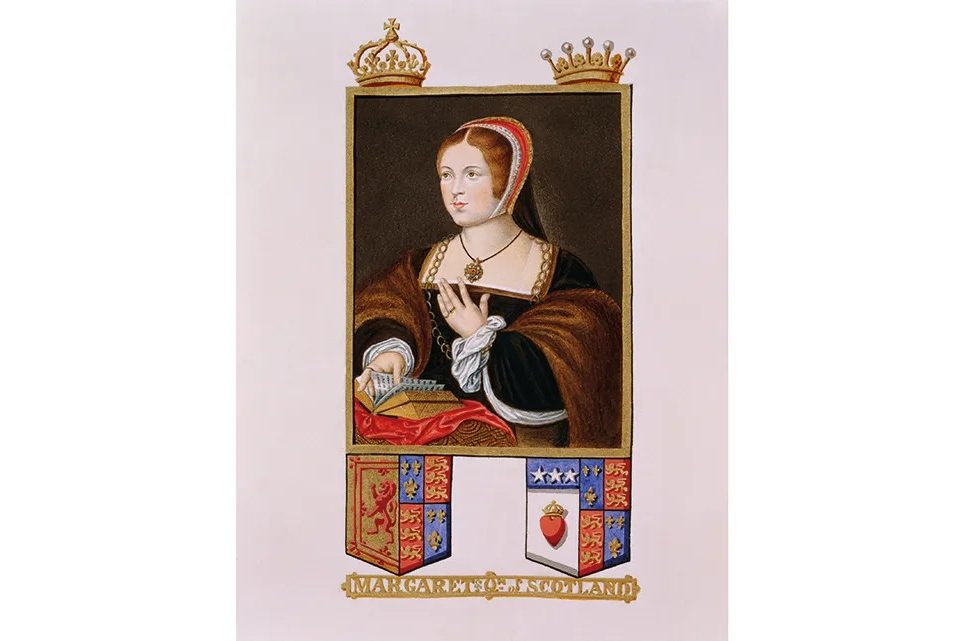The history of princesses and queens has become well-trodden ground in the women’s history genre, particularly the Tudors. Linda Porter’s The Thistle and the Rose, a life of Margaret Tudor, queen consort to James IV and mother of James V, provides a refreshing change in subject.
Margaret has had to share the stage with some of the most famous names and voices of the sixteenth century: Henry VII and his queen, Elizabeth of York; Henry VIII and his wives; and, of course, her namesake, Margaret Beaufort, the formidable Tudor matriarch who deftly helped place her son, the victor of Bosworth, on the throne. Margaret Tudor, though less considered in popular history, held equal if not greater sway in her contribution to history, as Porter demonstrates in her meticulously detailed biography of the English princess turned queen of Scotland.
The relationship between England and Scotland was fraught, with two centuries of war played out in the borderlands, a frontier zone peppered with garrisons. Margaret’s marriage to James IV of Scotland was intended to put an end to the fighting. Margaret’s importance to Anglo-Scottish peace has perhaps been overlooked by historians, but to her contemporaries, her marriage was a significant one. Aged thirteen (young even by the standards of the time), Margaret traveled from Richmond to Scotland while still in mourning. The recent loss of her mother and her brother Arthur “shook the royal family to its core.” Henry VII and Elizabeth had lived in fidelity, having built a marriage on love as well as duty, a union following the Wars of the Roses. If Margaret had the same expectations for her relationship with James IV she would be disappointed.
James was young, attractive and a notorious philanderer, with an established mistress. (His reputation later prompted Walter Scott to suggest that en route to Flodden he seduced the Lady Heron, resulting in her abandoning the defense of Ford Castle.) Nonetheless, James doted on his young wife, gifting her an intricately detailed Book of Hours which later included a miniature of Margaret kneeling at an altar bearing the words “God us Defend.” As queen, she did her duty and throughout her late teens she was almost constantly pregnant. Though there was much adversity in her life, the real tragedy was the loss of nearly all of her eight children, some in utero, others in the cradle or childhood. The emotional impact of this must have been unbearable, which perhaps — this being such an important part of a woman’s life — could have been given more attention in the narrative.
The couple did, however, have one healthy son, the future James V. His birth precipitated the death of his father at the Battle of Flodden in 1513, a scene colorfully described, from the position of the armies to the detail of the cannons and the eventual bloody fate of James IV. Noting the atrocity of the battle, Porter writes: “The scene of slaughter was so appalling that, at its height, the loss of life rivaled in intensity some of the actions of the Somme.”
It was James IV’s wish that his wife would act as regent in the event of his death, and she did so with grit. Her main incentive was the security of her surviving son and, this being a man’s world, her regency soon felt unsteady. Margaret made the ill-fated decision to remarry. In a secret ceremony, she wed Archibald Douglas, a member of one of Scotland’s oldest and most notorious families. For Porter, this was not a lustful whim but a carefully considered decision to protect the future of her children, “looking to shore up her power base and build on it.” Her plan rendered her regency obsolete and she was forced to flee to Henry VIII’s court, but following a well-timed return to Scotland, she eventually saw to it that her son was installed as James V.
Telling the lives of women is challenging, owing to the scarcity of information available. Even for royal women the evidence is scant. The archive itself is gendered. When the record has little to offer, there is even greater need for a close reading of the material that is available. In places, the book might have offered a bolder, more creative perspective to avoid the story orbiting around “great men.”
A valuable source, however, is a collection of Margaret’s personal letters. These detail her disputes with her brother Henry VIII, indicating Margaret’s determination to secure her immediate family by showing strength and resolve against a notorious tyrant. The letters, interwoven with literary material and immense detail concerning the state of Anglo-Scottish politics, make The Thistle and Rose a fine example of royal biography and a welcome addition to Tudor narrative history.
This article was originally published in The Spectator’s UK magazine. Subscribe to the World edition here.


























Leave a Reply